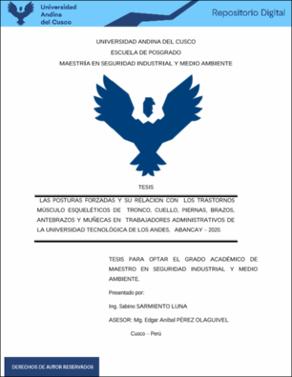| dc.contributor.advisor | Pérez Olaguivel, Edgar Aníbal | |
| dc.contributor.author | Sarmiento Luna, Sabino | |
| dc.date.accessioned | 2022-12-27T20:48:26Z | |
| dc.date.available | 2022-12-27T20:48:26Z | |
| dc.date.issued | 2022-09-13 | |
| dc.identifier.uri | https://hdl.handle.net/20.500.12557/5087 | |
| dc.description.abstract | En primer lugar, es necesario indicar que, “el objetivo general del presente estudio” ha sido
determinar “cuál es la relación de las posturas forzadas con el riesgo de padecer trastornos músculo
esqueléticos” (tronco, cuello, piernas, brazos, antebrazos y muñecas) en trabajadores
administrativos de la “Universidad Tecnológica de los Andes”. En esta misma línea, la hipótesis
general de la investigación estableció si las posturas forzadas se relacionan con el “riesgo de
padecer trastornos músculo esqueléticos de” “tronco, cuello, piernas, brazos, antebrazos y muñecas
en los” “trabajadores administrativos de la Universidad Tecnológica de los Andes”. Asimismo, la
investigación tuvo un “enfoque cuantitativo, de tipo aplicada, de alcance correlacional y de diseño
no experimental”. La población estudiada estuvo constituido por los “trabajadores administrativos
de la Universidad Tecnológica de los Andes” y con una muestra de 108, el muestreo aplicado
correspondió al aleatorio simple, la “técnica de recolección de datos fue” la medición con un
goniómetro digital de las posturas forzadas que optan diariamente para el desarrollo de sus
actividades, se utilizó “la hoja de campo del método REBA” “como instrumento de recolección de
datos”, la medida de correlación aplicada fue la de Pearson y con “un nivel de significancia del
95%”. Del mismo modo, de acuerdo con la correlación de Pearson calculada en la que se obtuvo
como resultado 0.60 “para un nivel de significancia del 95% se concluye” “que, si existe una
relación entre las posturas forzadas y el” “riesgo de padecer trastornos músculo esqueléticos de
tronco, cuello,” piernas, “brazos, antebrazos y muñecas”. Finalmente, se debe precisar que dicha
correlación es alta. | es_PE |
| dc.description.abstract | In the first place, we must indicate that “the general objective of this” study has been to determine
what is the relationship of forced postures with trastrskeletal disorders (“trunk, neck, legs, arms,
forearms and wrists”) in “administrative workers of the Technological University of the Andes”.
“On the other hand, the general hypothesis of the research established whether the forced postures
are related to the” musculoskeletal disorders of “the trunk, neck, legs, arms, forearms and wrists”
“in the administrative workers of the Technological University of the Andes”. Along the same
“lines, it is necessary to mention that the” “research had a quantitative approach, of an applied
type, of correlational scope and of a non-experimental design. The studied population was
constituted by” the administrative workers of the Technological University of the Andes and with
a sample of 108, the applied sampling corresponded to the simple random one, the data collection
technique was the measurement with a digital goniometer of the forced postures that they choose.
daily for “the development of their activities”, “the field sheet of the REBA” method was used as
a data collection instrument, the correlation measure applied was Pearson's and with a significance
level of 95%. On the other hand, according to the Pearson correlation calculated in which 0.60 was
obtained for a significance “level of” 95%, “it is concluded that” if “there is a relationship
between” “forced postures and musculoskeletal disorders of the” “trunk, neck, legs, arms, forearms
and wrists”. Finally, it should be specified that said correlation is high. | en_US |
| dc.format | application/pdf | es_PE |
| dc.language.iso | spa | es_PE |
| dc.publisher | Universidad Andina del Cusco | es_PE |
| dc.rights | info:eu-repo/semantics/openAccess | es_PE |
| dc.rights.uri | https://creativecommons.org/licenses/by-nc-nd/4.0/ | es_PE |
| dc.subject | Posturas forzadas | es_PE |
| dc.subject | Trastornos músculo esqueléticos | es_PE |
| dc.subject | Trabajadores administrativos | es_PE |
| dc.title | Las posturas forzadas y su relación con los trastornos músculo esqueléticos de tronco, cuello, piernas, brazos, antebrazos y muñecas en “trabajadores administrativos de la Universidad Tecnológica de los Andes,” Abancay – 2020. | es_PE |
| dc.type | info:eu-repo/semantics/masterThesis | es_PE |
| thesis.degree.name | Maestro en Seguridad Industrial y Medio Ambiente | es_PE |
| thesis.degree.grantor | Universidad Andina del Cusco. Escuela de Pos Grado | es_PE |
| thesis.degree.discipline | Seguridad Industrial y Medio Ambiente | es_PE |
| dc.publisher.country | PE | es_PE |
| dc.subject.ocde | https://purl.org/pe-repo/ocde/ford#5.07.01 | es_PE |
| renati.advisor.orcid | https://orcid.org/0000-0002-6016-1143 | es_PE |
| renati.author.dni | 71051372 | |
| renati.discipline | 022247 | es_PE |
| renati.juror | Naveda de Aramburu, Herminia | |
| renati.juror | Chuquimia Hurtado, Arturo | |
| renati.juror | Cavero Pacheco, Shaili Julie | |
| renati.juror | Chacón Sánchez, Víctor | |
| renati.level | https://purl.org/pe-repo/renati/level#maestro | es_PE |
| renati.type | https://purl.org/pe-repo/renati/type#tesis | es_PE |


